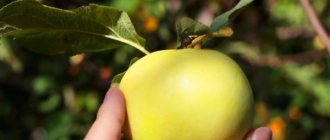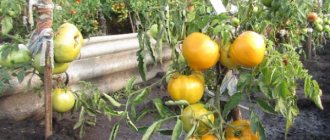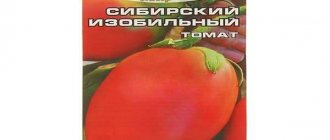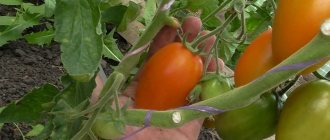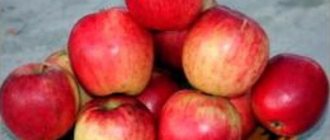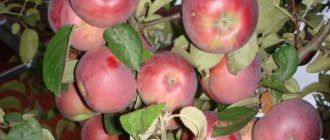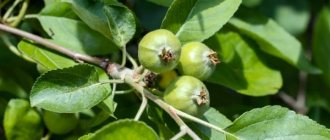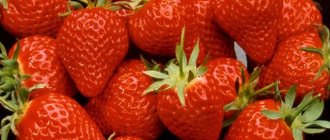Russian gardeners are accustomed to such fruit trees as apple, pear, cherry, and plum, but the idea of planting persimmons does not even occur to them. Although its frost-resistant varieties have long been bred and successfully survive in the climate of central Russia. One of them is Russian.
- 1.1 Appearance of tree and fruit
1.1.1 Video: what Russian persimmon looks like
- 2 The procedure for planting persimmons in the garden and the necessary preparation
2.1 Video: how to choose the right seedlings and plant persimmons
- 3.1 Video: tips for growing persimmons
Description of Russian persimmon variety
Persimmon Rossiyanka is one of the striking examples of successful hybrids that have emerged as a separate variety. The culture was developed in the late 50s of the 20th century by crossing Virginia and eastern persimmons. In general, the vast majority of persimmon varieties are quite heat-loving. While the resulting variety showed good resistance to cold .
The name of the persimmon variety “Rossiyanka” can be considered quite eloquent, because most of the territory of Russia is clearly not in the south. And these areas are hardly suitable for growing persimmons. But this is not the case with the Rossiyanka persimmon - it can be fearlessly planted in conditions, for example, in the Moscow region, and get good yields of golden fruits, widely known for their beneficial properties.
Collection, use and storage of crops
An adult Rossiyanka tree produces an average of 50–60 kg of fruit, and in particularly successful years – up to 80 kg. It produces its first full harvest at the age of 5–6 years. The fruits fully ripen at the end of November, when the tree has already shed its leaves. The harvest is harvested exclusively by hand, as if unscrewing the stalk.
Persimmon, when the leaves have already fallen from the tree, but the fruits are still hanging, looks very unusual
Technical ripeness occurs in October. Persimmons harvested at this stage are left to ripen in a dark, warm place with high humidity and good ventilation. The process will go faster if you put ripe apples and bananas nearby.
Even under optimal conditions, persimmons are not stored for long, a maximum of a month. She needs a temperature of no more than 15°C and high humidity.
After freezing, persimmons do not lose their taste and benefits, but they will require a lot of space to store them.
In addition to eating fresh, persimmons are frozen and dried. But storing frozen fruits will require a lot of space. It is also quite suitable for homemade preparations - compotes, preserves, jams, candied fruits.
Many people haven’t even tried persimmon jam, but it’s very tasty!
Planting, growing, care.
Landing
One-year-old seedlings are taken for planting Russian persimmon varieties. You can take a little older ones, but you should remember that the planting material should not be older than two years - otherwise it will be difficult for the tree to take root in a new place. When choosing a seedling, you should also pay attention to its root: is it branched enough, is it dry. Before planting, the roots of a young tree should be placed in a container of water for several hours.
A place for planting should be chosen that is sufficiently illuminated (persimmon does not like shadows), dry and protected from the winds. A piece of land next to the south wall of the house, for example, is perfect for this. Here you can dig a hole for planting in such a way that the depth of the roots of the tree does not exceed 0.5 meters. It should also be taken into account that the groundwater in this place should be located no closer than 70–80 cm to the surface. It is better to plant Russian persimmon in regions with harsh winters and cold autumn in the spring. If the climate is milder - in the fall.
Growing and care
When caring for a tree, you need to remember that severe waterlogging promotes the appearance of additional shoots, and not the growth and development of the tree itself. Therefore, excess moisture should be avoided .
In order for the plant to remain healthy and bear fruit well, you need to carry out the necessary minimum measures, such as:
- Loosening the soil must be carried out at least 5–6 times during the growing season.
- Watering should be regular. The soil should not be allowed to dry out (this is especially true for a young plant).
- Pruning (required) - to form the crown and increase productivity. Young growing trees especially need pruning. By removing excess shoots, you help direct its forces to development.
- Feeding. The recommended dose for a seedling is up to 15 kg of mineral and organic fertilizers, and for an adult tree - no more than 20 kg.
- Prevention of diseases and pests - use the usual preparations for persimmons.
The procedure for planting persimmons in the garden and the necessary preparation
It is better to plant persimmons in the southern regions in the fall, calculating the time so that there is at least a month left before the first frost. In temperate climates, the best time is May and early June.
Optimal conditions for Russian women:
- Good lighting. The site must be open.
- No cold drafts. The barrier should protect the tree, but not shade it.
- Sufficient space. The tree requires about 9 m² of area.
- Groundwater located at least 70 cm below the surface of the earth. Excess moisture in the soil provokes the active development of root shoots in young seedlings to the detriment of the tree itself.
- Loose, slightly acidic soil. Persimmon does not need particularly nutritious soil; in nature it grows on almost bare rocks.
Warmth and sunlight are necessary conditions for the ripening of any persimmon, so Rossiyanka cannot be planted in the shade.
High-quality planting material is very important. Persimmon is not the most common crop, so you may have to look for it in different nurseries. Choose seedlings 1–2 years old with a closed root system. Those that are older adapt very poorly to the changed environment. An annual plant is just a “stick” 0.5–0.7 m high, a biennial plant has 3–5 side shoots up to 30 cm long. The bark should be uniform, smooth and elastic, without traces of mold and rot, the branches should be flexible.
High-quality planting material is the key to abundant harvests in the future, so choose persimmon seedlings carefully
The planting hole is prepared a couple of weeks before planting persimmons in the fall. Its depth and diameter are about 60 cm. Drainage is poured onto the bottom in a layer of up to 10 cm, on top - a mixture of turf soil, peat, sand and humus (4:2:2:1) and 50–80 g of complex fertilizer containing nitrogen, phosphorus and potassium.
If you plan to plant persimmons in the fall, the hole is prepared in about two weeks; for this, when you postpone planting until spring, the holes are dug in the fall
The landing itself goes like this:
- Water the soil at the bottom of the hole moderately. When the water is absorbed, rake the soil into a mound.
- Stick a peg for support a little away from its center.
- At the top of the hill, make a depression large enough to accommodate the roots of the seedling.
- Remove the persimmon from the container, if possible without destroying the lump of soil on the roots. This is easier to do if you water the seedling well 2-3 hours before planting.
- Place the tree in the hole. Cover it with soil so that the root collar remains at the same level. Gently compact the substrate as you go, leaving no air pockets.
- Water the tree with water at room temperature with the addition of a biostimulant (Epin, Kornevin, Zircon), spending 8–10 liters per seedling. When it is absorbed, tie the persimmon to a support and mulch the soil. You can use peat and fresh sawdust to acidify the soil for this.
Mulching the tree trunk circle after planting persimmons helps to avoid too rapid evaporation of moisture from the soil, prevents it from “baking” into a hard crust and prevents the growth of weeds
If the root system is open, the roots are inspected, trimmed to healthy tissue, and soaked in a solution of any biostimulant for 2–3 hours. Then they are dipped into a clay-dung “matter” and allowed to dry. When planting, the main thing is to prevent the roots from bending up and to the sides, pointing them down. The root collar is buried 5–7 cm.
Video: how to choose the right seedlings and plant persimmons
Reviews of Russian persimmon variety
The resistance of the Rossiyanka persimmon variety to diseases and pests is especially noted. This resistance has a rather pleasant “bonus” - environmentally friendly fruits. After all, the tree does not need to be treated with chemicals, which means there will be no “chemistry” in the fruits. Clean cultivation - clean product.
Where can I buy
You can buy Rossiyanka persimmon seedlings in our online store. We ship orders throughout the country using Russian Post and TK. To order Russian persimmon seedlings, follow the link.
Previous:
- Phlox subulate: description of the variety, reviews, characteristics
- Plum Burbank Giant: variety description, reviews, characteristics
- Columnar plum Fortuna: variety description, reviews, characteristics
- In vitro technology
- Blueberries: general description, beneficial properties
Possible problems during cultivation
The Russian woman does not suffer from fungal diseases. The main danger for it is represented by scale insects and false scale insects that feed on the sap of leaves, as well as any caterpillars (cutworm butterflies, whitethorn butterflies, hawthorn butterflies, and so on) that eat greenery.
Any caterpillars are distinguished by their rare gluttony and omnivory - the greenery on the fruit trees they attack disappears literally before our eyes
Scale insects and false scale insects are round, grayish-brown “growths” on a tree. To get rid of them, use Aktara, Fufanon. Caterpillars are destroyed with any general insecticides - Actellik, Tanrek, Mospilan. Adults are repelled from trees by Lepidotsid, Bitoxibacillin. Any chemicals can be used if there is at least a month left before harvest.
Folk remedies against scale insects and false scale insects are ineffective: if you find a pest, immediately use insecticides
Types of persimmons for our regions
To determine the variety of persimmon that is most suitable for growing in a particular region, it is first recommended to study the varieties of the crop.
Caucasian persimmon (Diospyros lotus)
This type of persimmon grows in subtropical areas. In our stores, the fruits are often presented as a harvest of ordinary persimmon. The plant variety is distinguished by small fruits, up to 2.5 cm in diameter, with a tart taste. But despite this, they contain a large amount of vitamins and amino acids. Mature trees reach a height of more than 30 m. Caucasian persimmon blooms in late spring. The harvest ripens in mid-autumn. This persimmon is not characterized by high frost resistance. The hardiest varieties can withstand short-term frosts down to minus 25 degrees. That is why, for its cultivation in our latitudes, shelter for the winter period is necessary.
Virginia persimmon (Diospyros virginiana)
In nature, this type of persimmon grows in the USA, and is less common on the Mediterranean coast and in Ukraine. The medium-sized fruits (4-6 cm in diameter) have a unique nutritional value (the amount of sugar reaches 45%). Virginia persimmon trees are medium in size, up to 25 m high. Flowering begins in June, and harvesting begins in September. This species is considered very undemanding in terms of soil composition and air humidity, but requires plenty of lighting. Excellent frost resistance (withstands short frosts down to minus 35 degrees) allows you not to cover the trees for the winter period.
Eastern persimmon (Diospyros kaki)
A popular type of persimmon among gardeners, even though frosts of more than 18 degrees are destructive for it. Requires mandatory shelter for the winter period. Adult specimens are characterized by compact sizes (trees up to 10 m with a poorly developed crown). Blooms in late spring or early summer. The harvest ripens from mid-autumn until the beginning of winter. The ripening period directly depends on the variety that is cultivated in the garden. Oriental or Japanese persimmon, as it is also called, is distinguished by the largest fruits, the weight of which can reach up to 500 g. The taste of the fruits can be both sweet and very tart (the tartness does not go away even after freezing). High yields and minimal requirements for agricultural technology have made the Eastern type of persimmon a favorite among summer residents.
Virginia persimmon
Virginia persimmon is native to North America. The trees are medium-sized, up to 20 meters in height, with frost resistance up to -35 degrees. The root system can withstand soil freezing down to -15 degrees and therefore seedlings of this species are recommended to be used as rootstock for promoting cultivated varieties to more northern areas. Another valuable quality as a rootstock is that it can withstand and grow well on heavy clayey, waterlogged soils, and also has a longer period of natural winter dormancy, which does not provoke a premature start of sap flow of the cultivated variety due to prolonged winter thaws. It should be taken into account that cultivated varieties grafted onto Virginia persimmon tolerate replanting worse due to the peculiarity of having weakly branched tap roots, are more moisture-loving, develop more slowly, are less productive and less durable. There are cultivars called persimmons in America.
Nuances of plant care
Caring for a seemingly exotic persimmon with Russian complexity is no different:
- Get wet. Persimmons are grown very easily when the soil is waterlogged, and a dry substrate is absolutely not suitable for it. Given this, the plant is watered more often. Focus on how hot it is outside and how often it rains. Watering intervals vary from 5-7 to 2-3 days. The norm for an adult tree is 25-30 liters; seedlings need six months. To maintain soil acidity, add citric acid or apple cider vinegar to water a couple of times a month - 2-3 g or ml per 10 liters.
- Loosening. Persimmon prefers light, dry soil, so the soil should be loosened at least once every 7-10 days. An alternative to loosening and weeding is mulching.
- Application of fertilizers. Make food from the second year after planting. At the beginning of spring, persimmons need nitrogen (25-30 g per adult tree), during the flowering period, the formation of ovaries and after harvesting phosphorus and potassium (the dosage is approximately the same). She doesn't like any organic material, especially fresh ones.
Persimmons (except for the first time) are recommended to be fed with complex fertilizers containing not only macro- and microelements
- Finishing. The crowns of Russian persimmon can be formed in the shape of a bowl, without a pronounced central conductor, and as a sparsely tiered. The first option is the traditional choice of gardeners in the southern regions and the second middle zone. Formation of both configurations takes 3-4 years. Then you just need to support them, not forgetting the annual sanitary pruning, which is carried out in spring and autumn. Persimmon bears fruit only on annual growths.
Cupped crown is good because it allows you to limit the height of the tree and gives the fruit more or less uniform lighting
- Preparing for winter. The high frost resistance of Russians does not exclude winter shelter, especially for seedlings aged 4-5 years. To protect the roots, the tree trunks were filled with fresh mulch (up to a 10 cm layer). Because of the high trunk they spud, the trunk and skeletal branches (the lower third or half of it) are whitened. The trunk is wrapped in 2-3 layers of covering material.
Persimmons for the winter, prepared in the same way as any fruit tree
Hybrid form Nikitskaya Burgundy
The hybrid variety Nikitskaya Bordovaya was obtained as a result of experimental pollination of the Rossianka variety with Eastern persimmon.
It was developed by breeders from the Nikitsky Botanical Garden in Crimea, which is where its name came from.
The low-growing plant (height - 3-4 m) with a pyramidal crown is a frost-resistant species - can withstand temperatures down to -25 ° C. The fruits are burgundy in color, with an average weight of 100-120 g. They taste sweet, are covered with a waxy coating, and the pulp contains a small amount of seeds.
The harvest period is the first 2 weeks of October. This is a medium-yielding hybrid that produces from 50 to 70 kg of yield. Disease resistance is high.
general characteristics
Persimmon is a fruit of rich orange color, weighing up to 60 grams. It is not only distinguished by its excellent taste, but is also incredibly beneficial for human health.
Persimmon belongs to the Ebony family, and in total there are about 300 species of this wonderful fruit. The most famous are:
- Caucasian.
- Virginskaya.
- Eastern.
- Japanese.
- Black.
- Dagestan.
All these varieties are quite heat-loving, with rare exceptions. But how to grow persimmons in a region where the climate is quite peculiar: hot in summer and too cold in winter?
Advantages of "Rossiyanka"
In the 50s and 60s, in the Nikitsky Botanical Garden, A.K. Pasenkov, by crossing Virginia and Oriental persimmons, obtained an interspecific hybrid, which has a number of advantages compared to exotic heat-loving varieties:
- Full adaptation to the frosty and harsh winters of central Russia. Russian persimmon can withstand temperatures up to – 28 – 30 degrees.
- Fruiting occurs regardless of the sex of the tree.
- The first fruits can be collected quite quickly - within a few years after planting the seedling in the ground.
- When persimmon grows, there is no need to treat it with chemicals. This hybrid is absolutely immune to fungal infections and diseases. This is an important factor, since the value of environmentally friendly fruits is obvious.
Such distinctive features make it possible to grow the plant in our climate, including the Moscow region. And if you follow all the rules when caring and planting, you can grow an excellent, and most importantly, your own harvest of healthy fruits.
Description of the variety
The tree of this hybrid is usually of medium size - 4 - 5 meters. But sometimes it stretches up to 6 meters in height. The crown of the plant is spreading and wide. Therefore, you need to select a spacious place for planting.
- This variety bears fruit without pollination, which is convenient. He belongs to the intermediate group. But according to reviews from experienced gardeners, pollination still contributes to a significant improvement in the taste and softness of the fruit. Fruits with seeds are much juicier and more tender. Therefore, if you decide to plant a lot of seedlings, it is recommended to plant at least one pollinator for every 8 - 10 bushes. You can also irrigate the plant with a solution of gibberellin to pollinate flowers. This procedure will also protect the persimmon from dropping its flower stalks.
- It blooms in the first ten days of July. The flowers are soft pink, the shape is quite unusual - the petals curl a little.
- The leaves of the tree are dark green, oval and slightly oblong in shape. The structure is dense.
- The fruits are bright orange, round and slightly flattened in shape, small in size. During the period of incomplete ripening they have a barely noticeable whitish coating.
- The fruits fully ripen only towards the end of autumn. By this time, all the foliage has fallen, and the tree remains all colored with bright berries. Truly a simply magical sight!
- Not quite ripe persimmons are quite tart and astringent. For full ripening, it is worth placing the fruits in a cold place. When fully prepared, the berry has a wonderful taste.
Storing Russian persimmons, unfortunately, cannot be particularly long-term. It will be suitable for use only for 30 days. One mature tree of this variety is capable of producing 70 - 80 kg of fruit.
Contraindications for use
Wild persimmon contains the astringent substance tannin, so it should be used with extreme caution by anyone who has gastritis, peptic ulcers of the stomach or intestines. Doctors do not advise patients after surgery on these organs to eat this product.
For those who experience a burning sensation in the epigastric region after eating the fruit, the exotic fruit should be excluded from the diet.
Wild persimmon is contraindicated:
- for constipation (tannin has a binding effect and can cause the development of hemorrhoids);
- for diabetes mellitus, because The pulp contains large quantities of fructose and sucrose.
Small fruits grow densely on the branches
Suitable species and varieties
According to The Plant List, there are about 725 varieties of persimmon. Some of them are grown as garden crops. The following types are recommended for planting:
- Virginskaya . It grows up to 20 m in height, the root system has poor resistance to frost. It develops very slowly, it is important to control soil moisture. The fruits are very sweet;
- Eastern . The most common variety of persimmon comes from China. Has average stability indicators. Shows slow growth but high yield. The fruits are orange or red.
All varieties of persimmon are divided into variable and constant. The first type changes the color of the pulp depending on the method of pollination, the second type does not change the shade of the fruit. Depending on the taste, persimmons can be sweet or tart. When choosing a variety, it is recommended to give preference to zoned hybrids, as they have increased productivity and resistance to temperature changes.
Features of persimmon fruits
For those interested in how persimmons grow, it will be useful to know a little information about its fruits. In place of the female flowers, at the end of flowering, a green dense ovary is formed, inside which there can be up to 10 large elongated seeds. As the fruits ripen, they acquire an oval, pointed or rounded heart-shaped shape. There are varieties with flattened berries.
Depending on the variety and type, the color of ripe persimmon also changes, ranging from light yellow to almost brown. Ripening begins in September and continues until December, so when persimmons are grown in the Crimea, North Ossetia and Ukraine, they sometimes end up under snow.
Anyone who loves the sweet taste of persimmons knows that the fruits are divided into two categories.
- The first ones are tasty even if they are not too ripe. They have soft flesh without pronounced fibers, which becomes jelly-like in ripe fruits.
- In the second category of persimmon, the fruits become edible only after falling under the first frost or artificial freezing. The pulp of these varieties is coarser and contains more fiber.
Both varieties have their pros and cons. Persimmons with soft, delicious fruits do not tolerate long-term storage and transportation. The slightest damage to the skin threatens rapid spoilage. Hard, astringent fruits can be stored for up to 30–40 days, and then after exposure to sub-zero temperatures, enjoy a healthy delicacy.
Growing persimmons from seeds
Planting persimmons with seeds is preferred by flower growers who decide to grow a tree at home. The plant takes root well if you choose high-quality seed material and provide the seedlings with care.
Start preparing seeds in the spring. To do this, buy ripe fruits. Choose them carefully so that the persimmons do not have dents, stains, signs of disease or damage. Remove the seeds from the fruit, rinse and dry for several hours. It is advisable that these fruits be grown in similar climatic conditions.
Persimmon seeds
Germinate the seeds in a damp cloth, after dipping them in a growth stimulator. Wrap the fabric in cellophane and place it in a warm place to create a greenhouse effect. Ideally, seeds should germinate in 10-20 days. If this does not happen, there is no need to wait - buy a new persimmon and repeat the procedure.
Sprouted persimmon seed
When the seed hatches, transplant it into a pot with nutritious soil and begin caring for the seedling.
Have you sprouted several seeds at once? Then transplant each plant into a separate container so that later they are not crowded.
Persimmon sprout in a pot
The next season, at the beginning of summer, you can transplant the grown bush into an open area. Or continue growing it at home.
Grown persimmon at home
Useful tips for growing
To get a healthy, decorative and annually bearing tree, you need to take into account some simple rules of care:
- In the first years of its life, the tree should be pruned. Annual spring pruning helps not only to form the correct crown and increase productivity, but also to stimulate further growth, development and facilitate tree care. All branches growing in the wrong direction (at an angle of 40 ° C) must be cut. They thicken the crown, take away nutrients from the plant, as a result of which the tree grows poorly and bears fruit, or produces a harvest of small and tasteless fruits.
- Spring, when the last frost has passed, is the best time to plant this variety. You can plant persimmons in the fall, but the likelihood of its survival will be very small, because... seedlings may die at the first frost.
- This is a hybrid plant, so it does not require a pollinating tree.
- Considering that the tree reaches a large size in maturity - about 6 m, it should be given a lot of space when planting. Under this condition, it will grow better and bear fruit more abundantly.
The benefits and harms of persimmons for the body
Beneficial features
The fruits are very nutritious as they contain up to 19% glucose (fruit sugar). Nutritionists value them as a good source of vitamins, especially C and A. The tannins, carotenoids, flavonols and anthocyanidins present in the pulp and peel reduce cholesterol and blood pressure, alleviate complaints in diabetes, and have anti-sclerotic, anti-carcinogenic, and antioxidant effects.
The ancient Chinese realized early on that Diospyros had great healing powers. Practitioners of traditional medicine still use all parts of the plant. For example, remedies from the roots strengthen the heart, the bark treats burns, and the leaves are used to make tea, which is drunk for a variety of problems, including poor circulation and infectious diseases. Ripe berries are effective for gastrointestinal problems and high temperatures, and juice from unripe fruits is effective for pressure.
South Korean scientists, based on the results of a study at Gyeongnam University, concluded that persimmon helps prevent the formation of excess weight and cure obesity. They used an extract that inhibited the activity of a pancreatic enzyme, resulting in decreased absorption of dietary fat. Whether fresh berries have a similar effect is still unknown. However, despite the fructose content, they do not contribute to weight gain, as Parisian scientists have proven.
Experts from Yangzhou University examined 46 varieties of persimmon and found a total of 30 types of carotenoids in them. Among them, beta-cryptoxanthin predominated, which is part of the xanthophyll group and is known as a precursor of vitamin A. It makes up 30% of the total carotenoids and, compared to beta-carotene, is found in a much smaller number of vegetables and fruits. Persimmons are one of the best sources of this substance, along with pumpkin, chili peppers and tangerines.
According to scientists, beta-cryptoxanthin provides the body with vitamin A better than beta-carotene, which is associated with higher bioavailability. The comparison showed that it is as much as 725% larger. The beneficial carotenoid reduces the likelihood of death in people with lung cancer. It prevents the growth of malignant cells and protects the lungs by counteracting the development of inflammation. Eating fruits rich in this substance helps reduce the risk of developing osteoporosis and insulin resistance, as well as liver dysfunction.
Another useful carotenoid is zeaxanthin, which is abundant in the pulp. Zeaxanthin, like cryptoxanthin, is a xanthophyll and protects against eye diseases, such as glaucoma. The content of carotenoids increases in fruits as they ripen.
Unripe berries, rich in tannins, are used in traditional medicine. They are effective against free radicals, pathogens, allergies, hypertension, stroke and cancer.
Persimmon contraindications
- Rare cases of an allergic reaction after eating berries have been described in people with pollen allergies. It manifested itself in the form of hives or red spots on the face. There were isolated cases of anaphylactic shock.
- Unripe fruits contain soluble tannin shibuol, which comes into contact with acid, polymerizes in the stomach and forms a sticky clot - phytobezoar. The latter can combine with other contents and often has a dense consistency. Such formations appear from unripe berries in more than 85% of cases.
In areas where the crop is grown, bezoar stones are a real scourge. According to experts, if the berries are ripe and in moderation, then the risk of dangerous foreign bodies is almost zero. It is also not recommended to consume fruits on an empty stomach.
Interesting fact: Scientists have found that if you have a bezoar, Coca-Cola helps you avoid surgery. Under the influence of the drink, the stone shrinks or disappears altogether.
How to plant a plant correctly
For planting, seedlings are taken that are no more than two years old. Before starting work, perform several preparatory operations:
- Choose a place to plant a seedling. The soil should be loose and acidic. To obtain the desired acidity, peat or pine sawdust is added to the soil.
- To ensure that the soil is well ventilated and warmed up, the pit is prepared in advance. It is made with dimensions of 60 x 60 x 60 cm. Sand and loose load with manure are added to it in equal proportions.
- To protect the young seedling from strong gusts of wind, a high peg is inserted into the hole.

